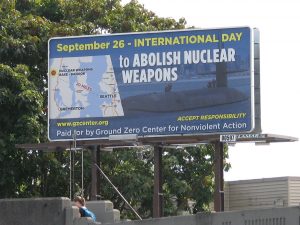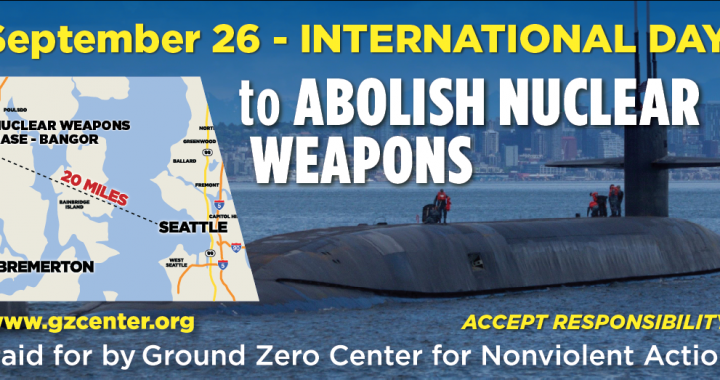Beginning August 30th, and continuing for four weeks, billboards in four Seattle locations are displaying the following paid advertisement: September 26 – INTERNATIONAL DAY to ABOLISH NUCLEAR WEAPONS! Included in the advertisement is a map showing the proximity of Seattle to Naval Base Kitsap-Bangor, homeport for 8 of the Navy’s 14 Trident nuclear-powered ballistic missile submarines, and a U.S. Navy photo of the Trident submarine, USS Nebraska, taken on June 2, 2017 near Elliott Bay.
The ad refers to the United Nations International Day for the Total Elimination of Nuclear Weapons, designated by the UN General Assembly in 2013. UN Member States, civil society organizations, academia, parliamentarians, the mass media and individuals are encouraged to commemorate and promote the International Day through enhancing public awareness and education about the threat posed to humanity by nuclear weapons and the necessity for their total elimination.
The ad seeks to inform citizens in the Puget Sound region of the importance of abolishing nuclear weapons and our relationship to Naval Base Kitsap-Bangor with the largest concentration of deployed nuclear weapons in the U.S.
The statement, Accept Responsibility, is a plea for citizens of Puget Sound to accept their role and responsibility–as taxpayers, as members of a democratic society, and as neighbors to the Trident nuclear submarine base in Hood Canal–to work to prevent the use of nuclear weapons.

Billboard on Aurora Avenue (photo by Tom Krebsbach)
Naval Base Kitsap-Bangor is homeport to the largest concentration of deployed nuclear warheads in the U.S. Hans M. Kristensen is the expert source for this statement. (See cited source material here and here.) Mr. Kristensen is director of the Nuclear Information Project at the Federation of American Scientists where he provides the public with analysis and background information about the status of nuclear forces and the role of nuclear weapons.
There are eight Trident SSBN submarines deployed at Bangor. Six Trident SSBN submarines are deployed on the East Coast at Kings Bay, Georgia.
One Trident submarine carries the destructive force of over 1,200 Hiroshima bombs (the Hiroshima bomb was 15 kilotons).
Each Trident submarine was originally equipped for 24 Trident missiles. In 2015-2017 four missile tubes were deactivated on each submarine as a result of the New START Treaty. Currently, each Trident submarine deploys with 20 D-5 missiles and about 90 nuclear warheads (an average of 4-5 warheads per missile). The warheads are either the W76-1 90-kiloton or W88 455-kiloton warheads.
The Navy in early 2020 started deploying the new W76-2 low-yield warhead (approximately eight kilotons) on select ballistic submarine missiles at Bangor (following initial deployment in the Atlantic in December 2019). The warhead was deployed to deter Russian first use of tactical nuclear weapons, dangerously creating a lower threshold for the use of U.S. strategic nuclear weapons.
Any use of nuclear weapons against another nuclear weapon state would likely elicit a response with nuclear weapons, causing overwhelming death and destruction. Besides the direct effects on the adversaries, the associated radioactive fallout would affect people in other nations. The global human and economic impacts would be far beyond imagination, and orders of magnitude beyond the effects of the coronavirus pandemic.
The billboards are an effort by Ground Zero Center for Nonviolent Action, a grassroots organization in Poulsbo, Washington, to reawaken public awareness of the dangers of nuclear weapons in the Puget Sound region.
CIVIC RESPONSIBILITY AND NUCLEAR WEAPONS
Our proximity to the largest number of deployed strategic nuclear weapons puts us near a dangerous local and international threat. When citizens become aware of their role in the prospect of nuclear war, or the risk of a nuclear accident, the issue is no longer an abstraction. Our proximity to Bangor demands a deeper response.
Citizens in a democracy also have responsibilities–which include choosing our leaders and staying informed about what our government is doing. The submarine base at Bangor is 20 miles from downtown Seattle, yet only a small percentage of citizens in our region know that Naval Base Kitsap-Bangor exists.
Citizens of Washington State consistently elect governmental officials who support nuclear weapons in Washington State. In the 1970s, Senator Henry Jackson convinced the Pentagon to locate the Trident submarine base on the Hood Canal, while Senator Warren Magnuson obtained funding for roads and other impacts caused by the Trident base. The only Trident submarine to be named after a person (and our former Washington State Senator) is the USS Henry M. Jackson (SSBN-730), homeported at Naval Base Kitsap-Bangor.
In 2012, Washington State established the Washington Military Alliance (WMA), strongly promoted by both Governor’s Gregoire and Inslee. The WMA, Department of Defense, and other governmental agencies work to strengthen the role of Washington State as a “…Power Projection Platform (Strategic Ports, Rail, Roads, and Airports) [with] the complementary air, land, and sea units with which to accomplish the mission.” Also see “power projection.”
Naval Base Kitsap-Bangor and the Trident submarine system have evolved since the first Trident submarine arrived in August 1982. The base has upgraded to a much larger D-5 missile with a larger W88 (455 kiloton) warhead, with ongoing modernization of missile guidance and control systems. The Navy has recently deployed the smaller W76-2“low-yield” or tactical nuclear weapon (approximately eight kilotons) on select ballistic submarine missiles at Bangor, dangerously creating a lower threshold for the use of nuclear weapons.
THE ISSUES
* The U.S. is spending more on nuclear weapons programs than during the height of the Cold War.
* The U.S. currently plans to spend an estimated $1.7 trillion over 30 years for rebuilding the nation’s nuclear facilities and modernizing nuclear weapons.
* The New York Times reported that the U. S., Russia and China are aggressively pursuing a new generation of smaller and less destructive nuclear weapons. The buildups threaten to revive a Cold War-era arms race and unsettle the balance of power among nations.
* The U.S. Navy states that SSBN submarines on patrol provide the U.S. with its “most survivable and enduring nuclear strike capability.” However, SSBNs in port and nuclear warheads stored at SWFPAC are likely a first target in a nuclear war. Google imagery from 2018 shows three SSBN submarines on the Hood Canal waterfront.
* An accident involving nuclear weapons occurred on November 2003 when a ladder penetrated a nuclear nosecone during a routine missile offloading at the Explosives Handling Wharf at Bangor. All missile-handling operations at SWFPAC were stopped for nine weeks until Bangor could be recertified for handling nuclear weapons. Three top commanders were fired, but the public was never informed until information was leaked to the media in March 2004.
* Public responses from governmental officials to the 2003 missile accident were generally in the form of surprise and disappointment
* Due to ongoing modernization and maintenance programs for warheads at Bangor, nuclear warheads are routinely shipped in unmarked trucks between the Department of Energy Pantex Plant near Amarillo, Texas and the Bangor base. Unlike the Navy at Bangor, the DOE actively promotes emergency preparedness.
THE BILLBOARD ADS
The four billboard ads are being displayed from August 30th through September 26th and measure 10 ft. 6 in. tall by 22 ft. 9 in. in length. The billboards are near the following locations:
* MLK Jr. Way and S. Jackson St.
* Aurora Ave. N. and N 41st St.
* Elliott Ave. W. and W Mercer Pl.
* E. Marginal Way S. and S. Mead St.
The photo of the submarine in the ad is from a U.S. Navy DVIDS website, at https://www.dvidshub.net/
170602-N-TA321-501 PUGET SOUND, Wash. (June 02, 2017) The Ohio-class ballistic-missile submarine USS Nebraska (SSBN 739) passes by Seattle during sea trials after completing an extended major maintenance period, to include an engineered refueling overhaul at Puget Sound Naval Shipyard and Intermediate Maintenance Facility. (U.S. Navy photo by Culinary Specialist Seaman Joseph W. Weiser/Released)
NUCLEAR WEAPONS AND RESISTANCE
In the 1970s and 1980s, thousands demonstrated against nuclear weapons at the Bangor base and hundreds were arrested. Seattle Archbishop Hunthausen had proclaimed the Bangor submarine base the “Auschwitz of Puget Sound” and in 1982 began to withhold half of his federal taxes in protest of “our nation’s continuing involvement in the race for nuclear arms supremacy.”
One Trident SSBN submarine at Bangor is estimated to carry about 90 nuclear warheads. The W76 and W88 warheads at Bangor are equal respectively to 90 kilotons and 455 kilotons of TNT in destructive force. One submarine deployed at Bangor is equal to more than 1,200 Hiroshima-sized nuclear bombs.
On May 27, 2016, President Obama spoke in Hiroshima and called for an end to nuclear weapons. He said that the nuclear powers “…must have the courage to escape the logic of fear, and pursue a world without them.” Obama added, “We must change our mindset about war itself.”
______________________________
The Ground Zero Center for Nonviolent Action was founded in 1977. The center is on 3.8 acres adjoining the Trident submarine base at Bangor, Washington. The Ground Zero Center for Nonviolent Action offers the opportunity to explore the roots of violence and injustice in our world and to experience the transforming power of love through nonviolent direct action. We resist all nuclear weapons, especially the Trident ballistic missile system.




